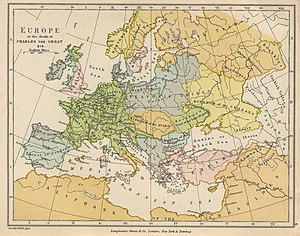This is an old revision of this page, as edited by Finnedi (talk | contribs) at 23:24, 8 April 2014 (Rv. The map restored. Textual improvements restored. The matter concerning Charles IX has already been discussed.). The present address (URL) is a permanent link to this revision, which may differ significantly from the current revision.
Revision as of 23:24, 8 April 2014 by Finnedi (talk | contribs) (Rv. The map restored. Textual improvements restored. The matter concerning Charles IX has already been discussed.)(diff) ← Previous revision | Latest revision (diff) | Newer revision → (diff)A few Icelandic sagas tell about kings that ruled in Kvenland .

Icelandic sagas
See also: KvenlandDespite the fact that the legendary title "King of Kvenland" appears widely used in various contexts, it is mentioned only once in that particular form/spelling in sagas:
In Egil's saga Faravid is directly said to be the "King of Kvenland". He also appears to have been a Kven himself.
Two other sagas mention Kvenland, Hversu Noregr byggdist and Orkneyinga saga,. The latter begins with a mention of a king named Fornjót, "who ruled over those lands which are called Finland and Kvenland". Unlike Egil's saga, Orkneyinga does not provide additional clues about the ethnicity of Fornjót or his descendants. The content however reveals he was neither Danish (Dane), nor Swedish (Svea).
Hversu Noregr byggdist has a similar usage for the title. This time, Fornjót's (who is said to be "a man") great-grandson Old Snow and his son Thorri are told to be kings. Kvenland now appears in relation to Thorri of whom it is said that "he ruled over Gothland, Kvenland (Kænlandi), and Finland". Fornjót's great-grandson Old Snow is also mentioned in Ynglingasaga, in relation to Finland.
Interpretations of their ethnicity have been made based on other information provided. For instance, according to Hversu Noregr byggdist the Kvens made sacrifices to Thorri. This, along with similar pieces of information from other sources, has led many experts to believe that Thorri, who ruled over Kvenland, was himself of Kven origin as well.
Whether Fornjót and his closest followers, mentioned in other medieval accounts as well, were actual historical people has been debated. Kyösti Julku notes that no geographical errors have been found in the descriptions of the Orkneyinga saga. He asks why therefore the people described in the account should be considered not to have existed.
Records on Fornjót's offspring
According to the account of Hversu Noregr byggðist, Fornjót's great-grandson Old Snow and his son Thorri were also kings. Old Snow is also mentioned in Ynglingasaga, in relation to Finland. According to Hversu Noregr byggdist, Thorri "ruled over Gothland, Kvenland (Kænlandi), and Finland". According to the information given, the Kvens made sacrifices to Thorri.
The medieval accounts which discuss the lineages sprung from Fornjót and his descendants - mainly Nór and Gór -, leading to the later rulers of Sweden and other countries, include the following:
The Beowulf (8th-10th century), Íslendingabók (8th-10th century), Poetic Edda (c. 800-1000), the Ynglingatal (late 9th century), Historia Norvegiæ (late 12th century), Skáldskaparmál (c. 1220), Hyndluljóð (13th century), Gesta Danorum (started c. 1185, finished c. 1216), Ynglinga saga (c. 1225), Orkneyinga Saga (c. 1230), Hversu Noregr byggðist (c. 1387), Ættartolur (1387).
See also
References
- http://www.emersonkent.com/images/maps/europe_814.jpg
- Egil's Saga, Chapter XIV
- Hversu Noregr byggdist
- Orkneyinga saga
- http://oaks.nvg.org/an6ra16.html
- Ynglingasaga
- Julku, Kyösti: Kvenland - Kainuunmaa. With English summary: The Ancient territory of Kainuu. Oulu, 1986.